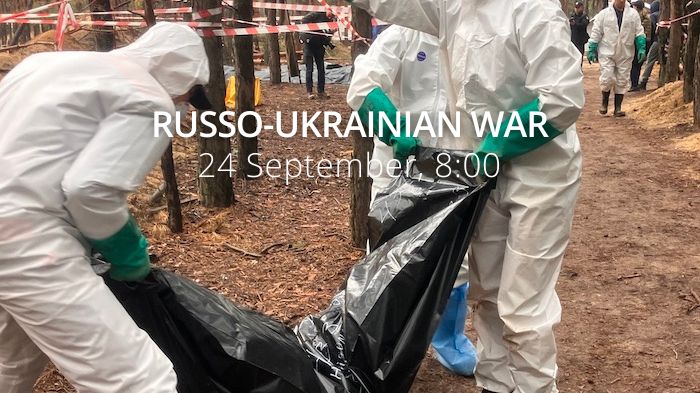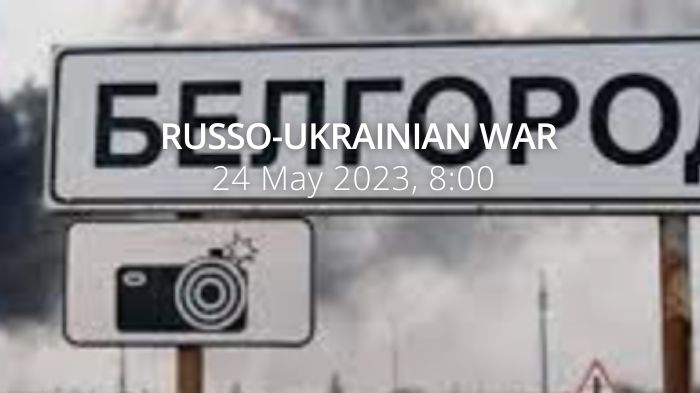Ukrainian drones reported near Moscow. Ukrainian parliament extends martial law and mobilization. Putin promises African leaders "free grain."
Daily overview — Summary report, July 28
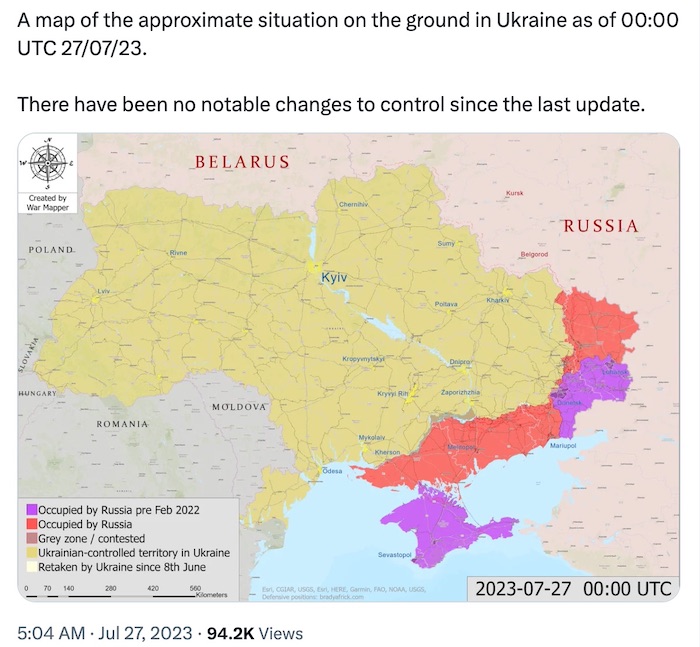
According to information from the General Staff as of 06.00 28.07.2023, supplemented by its [18:00 assessment].

“[On July 27, Russian occupiers launched a missile-air strike on the territory of Ukraine, using 2 Kalibr missiles at port infrastructure of Odesa and 8 Shahed-type strike drones. Due to successful combat work Air Defence Forces, all 8 "Shaheds" were destroyed.]
On July 27, the enemy launched 3 missile and 29 airstrikes, more than 70 MLRS attacks at the positions of Ukrainian troops and various settlements. Unfortunately, the Russian terrorist attacks have killed and injured civilians, as well as destroyed or damaged port infrastructure in the south of Ukraine and residential buildings.
The likelihood of missile and airstrikes across Ukraine remains very high.
On July 27, there were more than 30 combat engagements.
- Volyn and Polissya axes: no significant changes. [There are no signs of the offensive groupings formation.]
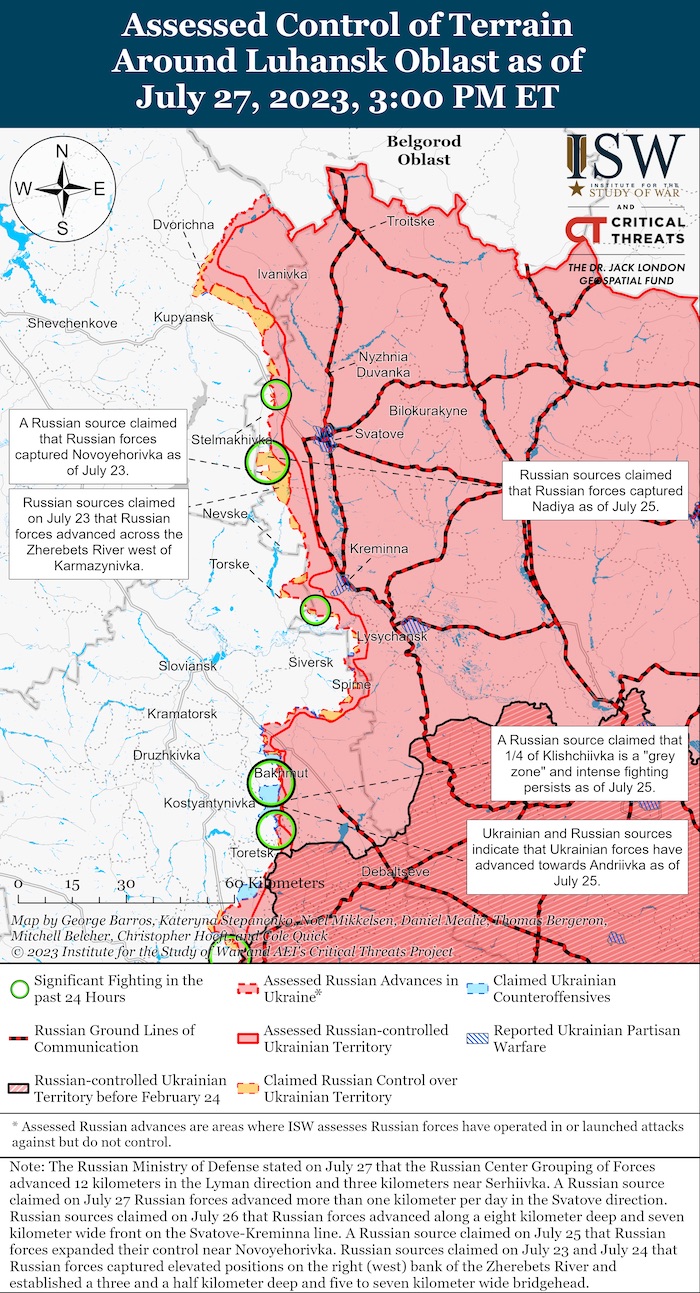
- Sivershchyna and Slobozhanshchyna axes: the adversary fired mortars and artillery at more than 35 settlements, including Novovasylivka, Stara Huta, Iskryskivshchyna, Volfyne, Bilovody, Pokrovka (Sumy oblast), Hur’yiv Kozachok, Udy, Bochkove, Mala Vovcha, and Budarky (Kharkiv oblast).
- Kupiansk axis: the adversary launched an airstrike in the vicinity of Iziums’ke (Kharkiv oblast). The invaders shelled Fyholivka, Dvorichna, Zapadne, Kyslivka, and Novoosynove (Kharkiv oblast) with artillery and mortars.
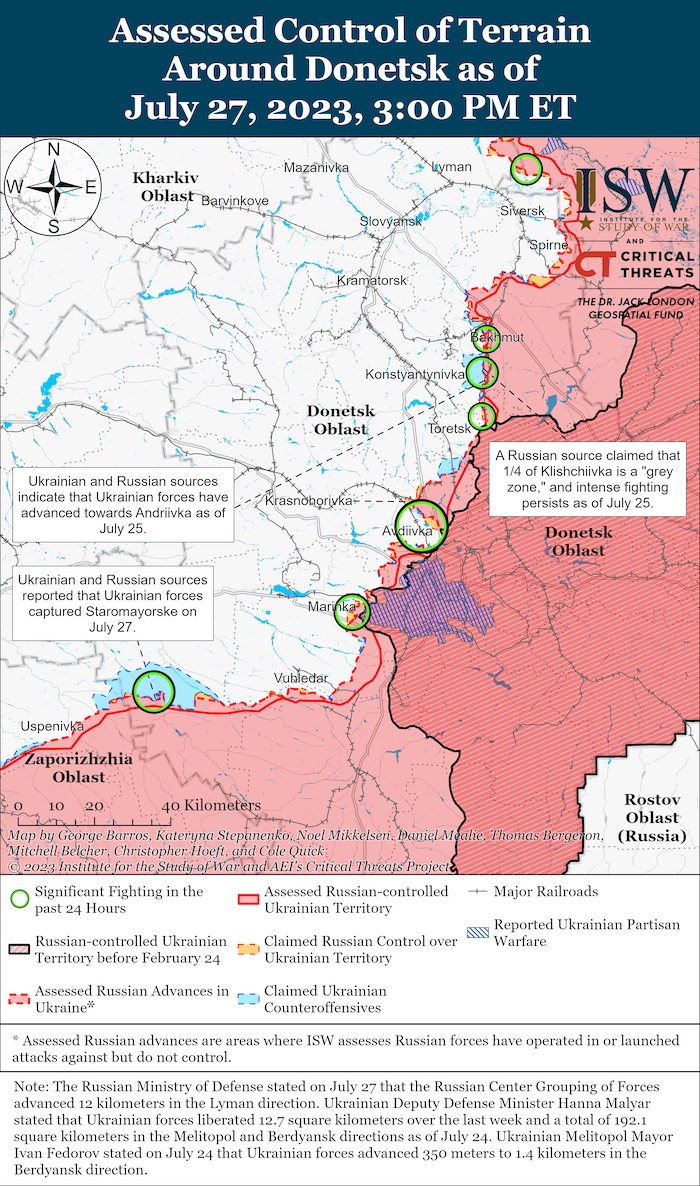
- Lyman axis: the enemy conducted unsuccessful offensives in the vicinity of Nadiya and launched an airstrike near Bilohorivka (Luhansk oblast). The settlements of Nevs’ke, Bilohorivka (Luhansk oblast), Spirne, Berestove, Tors’ke, and Verkhn’okam’yans’ke (Donetsk oblast) were shelled with artillery.
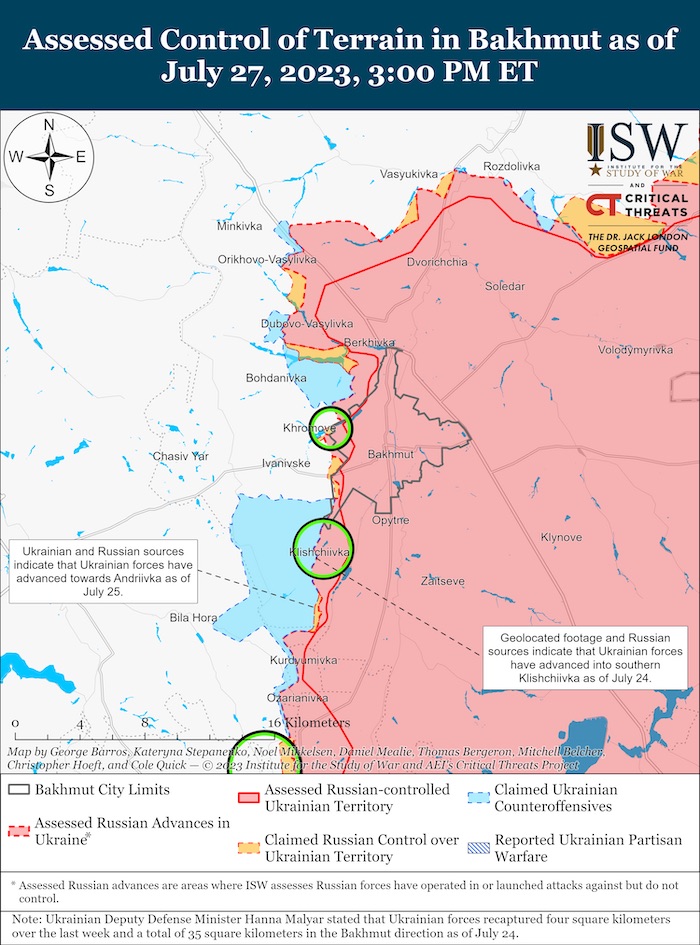
- Bakhmut axis: the Ukrainian defenders successfully repelled adversary attacks in the areas west and south of Klishchiivka (Donetsk oblast). The enemy launched airstrikes in the vicinities of Kurdyumivka, Bila Hora, and New York (Donetsk oblast). More than 10 settlements, including Razdolivka, Min’kivka, Predtechyne, Torets’k, and New York (Donetsk oblast), suffered from enemy artillery shelling.
- Avdiivka axis: under heavy fire from enemy aircraft and artillery, the Ukrainian defenders successfully repelled Russian troops’ attacks in the vicinity of Avdiivka. The invaders fired artillery at more than 15 settlements, including Avdiivka, Lastochkyne, Vodyane, Pervomais’ke, and Karlivka (Donetsk oblast).
- Marinka axis: the Ukrainian Defence Forces continue to hold back the Russian offensive in the vicinity of the city of Mar’inka. The adversary shelled more than 10 settlements, including Krasnohorivka, Heorhiivka, Mar’inka, Kurakhivka, Pobjeda, and Novomykhailivka (Donetsk oblast).
- Shakhtarske axis: under heavy [assaults] from aircraft and artillery, the Ukrainian Defense Forces liberated the settlement of Staromaiors’ke (Donetsk oblast). The adversary made unsuccessful attempts to regain the lost ground in the vicinities of Rivnopil’ and Makarivka (Donetsk oblast). The occupiers shelled the settlements of Paraskoviivka, Novomykhailivka, and Vuhledar, and Blahodatne (Donetsk oblast).
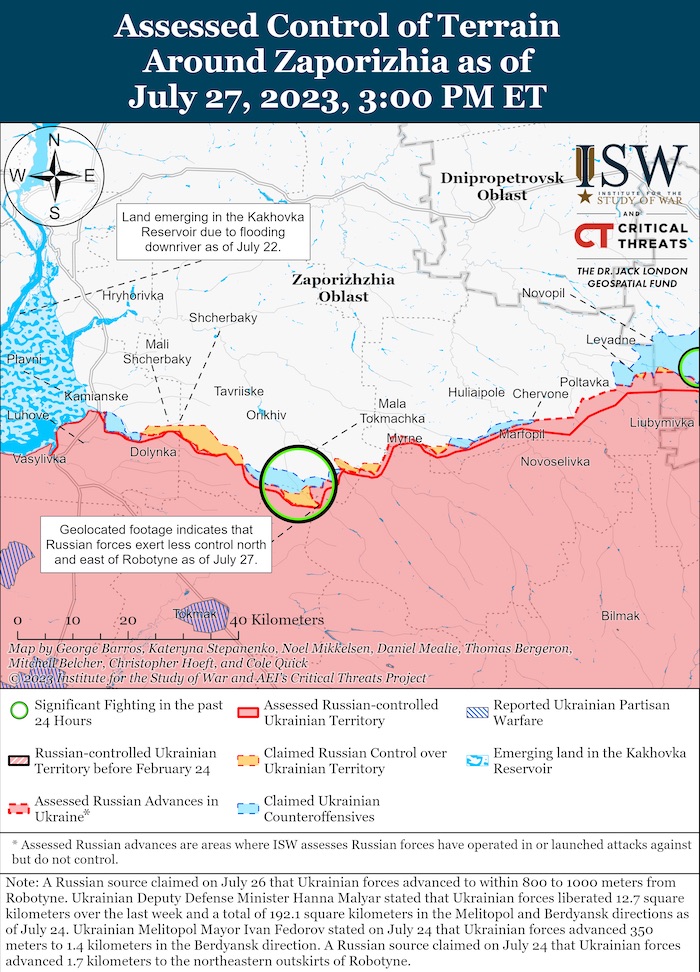
- Zaporizhzhia and Kherson axes: the adversary focuses its main efforts on preventing further advance of Ukrainian troops. Russian forces launched an airstrike in the vicinity of Novoberyslav (Kherson oblast). More than 15 settlements came under artillery fire, including Novodarivka, Hulyaipole, Charivne, Bilohir’ya, Kam’yans’ke (Zaporizhzhia oblast), Nikopol’ (Dnipropetrovsk oblast), Mykhailivka, Zmiivka, Odradokam’yanka, L’vove, Tokarivka, Antonivka, and Rozlyv (Kherson oblast). At the same time, the Ukrainian Defense Forces continue to conduct the offensive operation on Melitopol’ and Berdyans’k axes, consolidating their positions.
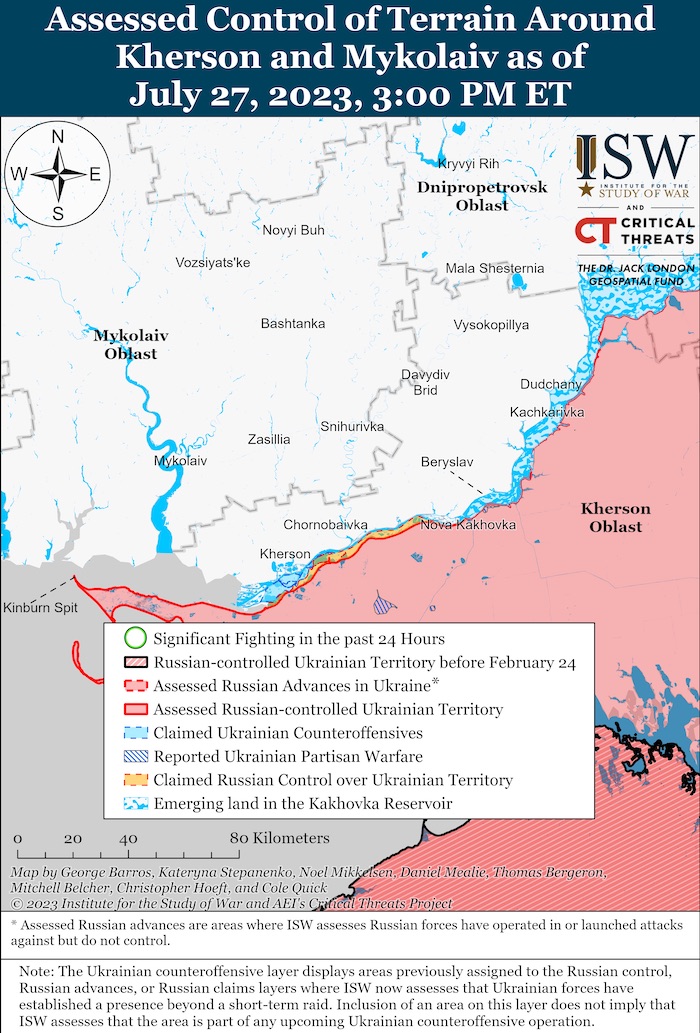
Military Updates
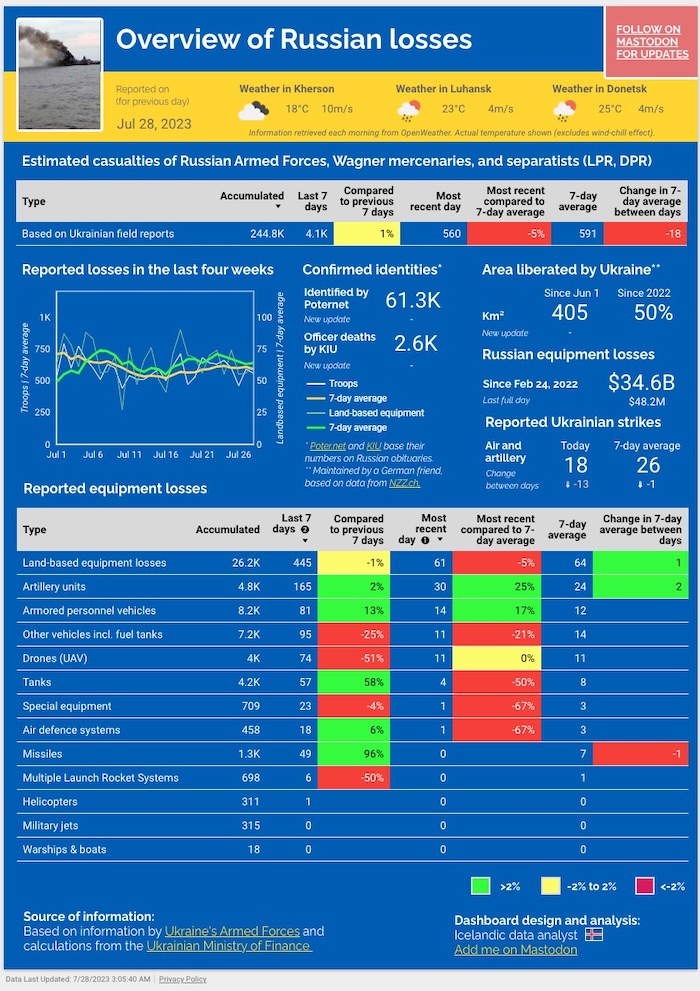
The Russian occupation forces continue to send newly mobilized soldiers with no prior combat training into combat. For example, about 110 mobilized servicemen from the Russian Federation arrived at the training camp of one of the units of the Russian occupation forces in the settlement of Rohove (Luhansk oblast). When they were issued gear and weapons, the Russian command informed the newly arrived personnel that they would be included in assault units and sent to the area of combat missions on the line of contact in the near future.
On July 27, Ukrainian Air Force launched 7 airstrikes on the concentrations of enemy troops, weapons, and military equipment, 1 airstrikes on the anti-aircraft missile systems, and 1 on a command post of the enemy. Also, the Ukrainian defenders intercepted 8 Shahed-136 combat UAVs and 5 operational-tactical level reconnaissance UAVs of the enemy on July 27.
On July 27, the Ukrainian missile and artillery troops hit 1 command post, 1 concentration of troops, 5 artillery systems at their firing positions, 1 fuel and lubricants depot, and 1 electronic warfare station of the adversary.“
Russians find it increasingly difficult to resist Defence Forces - Defence Ministry, Censor.net reports, citing Ukrinform with reference to Deputy Defence Minister Hanna Maliar. "The main task we are facing now, besides moving forward, is, of course, to weaken the enemy's ability to defend itself. And, in fact, this is what we are doing now. Dozens of weapons depots are destroyed every week, and hundreds of Russian soldiers and their equipment are destroyed every day. We already see signs that it is becoming more and more difficult for the enemy to resist. And our defenders are full of strength to move on, she said.
She added that gradually but surely the Defence Forces are advancing on the southern offensive directions - Melitopol and Berdiansk. We are moving, but we need to understand the enemy's efforts and resistance, she summarized."
Ukrainian army repels several enemy attacks in Kupiansk direction without losing positions, Ukrinform reports, citing Deputy Defence Minister Hanna Maliar said this on Telegram. “In Bakhmut direction, southern to Bakhmut, the Defence Forces are gradually moving forward. At the same time, Ukrainian defenders repelled several enemy attacks in Kupiansk without losing positions.
In Bakhmut direction on the south of Bakhmut we are gradually moving forward. Fighting continues in the area of Klishchiivka, Kurdiumivka, Andriivka. The fighting is quite fierce. The enemy is firing intensively. We are repelling enemy attacks north of Bakhmut, said Maliar.
According to her, the enemy is attacking in Kupiansk direction, trying to drive us out of the dominant heights. Today our defenders repelled several attacks without losing positions, noted Maliar. She added that several enemy attacks in the area of Serebrianskyi forest were also repelled in the Lyman direction today.»
On the night of July 27, 2023, the Russian Federation attacked from the southeastern direction with attack UAVs and cruise missiles, the Ukrainian General Staff reports. “In total, two launches of the KR "Kalibr" from a submarine, from the waters of the Black Sea, and eight Iranian kamikaze drones of the "Shahed" type from the direction of Primorsko-Akhtarsk were recorded. Kalibrs attacked the port infrastructure of Odesa, unfortunately, it was not possible to hit the missiles, there is damage and casualties.
All eight "shaheed" launched by the enemy were destroyed by the forces and means of the Air Force within the borders of Khmelnytskyi, Dnipropetrovsk and Donetsk regions.”
Russia says downs Ukrainian drone near Moscow – RIA, Reuters reports. “Russian air defences downed a Ukrainian military drone before it could attack its targets near Moscow on Friday, the RIA news agency cited Russia's defence ministry as saying. The ministry said the incident has caused no casualties or damage to buildings.”
Air Force confirms Russia's use of Kinzhal missiles on 26 July: There is destruction, Ukrainska Pravda reports, citing Colonel Yurii Ihnat, spokesperson for the Air Force of Ukraine. "Yesterday, in addition to the missiles that flew one after the other from the southeast and were headed first seemingly to Kharkiv [Oblast], then to Dnipropetrovsk [Oblast], and then went to the south, from there to the west, and then to Khmelnytskyi Oblast, namely Starokostiantyniv; at the same time the enemy decided to also strike from the north using MiG-31K aircraft with Kinzhal missiles.
...there is some damage [on the territory of the airfield – ed.], which, of course, we will not report, but the enemy did use those four Kinzhal missiles, and they were visible. […] There is a military airfield in Starokostiantyniv that hosts Ukrainian Su-24M tactical bombers. These aircraft serve as carriers of the Storm Shadow cruise missiles.”
On July 26, 36 enemy cruise missiles were destroyed, the Ukrainian General Staff reports. “On July 26, 2023, the Russian invaders launched two missile strikes on the territory of Ukraine. We reported earlier about the Kalibr attack in the afternoon. According to detailed information, not two, but three Kalibr cruise missiles were destroyed. Around 5:00 p.m., the enemy attacked from the Caspian Sea region with Kh-101/Kh-555 air-based cruise missiles. Launches of 36 missiles from eight Tu-95MS strategic bombers were recorded. The missiles entered the airspace of Ukraine from the south-eastern direction, went to the West, constantly changing the direction of flight. Anti-aircraft defence worked along the missile tracking route: anti-aircraft missile units, mobile fire groups, fighter aircraft of the Air Force and air defence of other components of the Defence Forces of Ukraine.
In addition, around 19:00, the occupiers raised MiG-31K fighters into the sky and struck with four Kh-47 "Kinjal" aeroballistic missiles in the direction of Khmelnytskyi region.
According to the results of combat work, the air defense of Ukraine destroyed 36 air targets: 3 Kalibr cruise missiles; 33 Kh-101/Kh-555 cruise missiles. Regarding the consequences of the Kh-47 "Kinzhal" launches, information is being clarified.”
Russian army keeps 15 warships in Black Sea - Military Spox, Ukrinform reports, citing the spokesperson of the Joint Press Center of the Southern Defense Forces of Ukraine, Nataliia Humeniuk. “The situation remains difficult and is also complicated by weather conditions - a storm is raging, and it is quite powerful, and the stormy weather will last for at least a certain number of hours, and perhaps even stretch for two days, but this does not prevent the enemy from keeping the missile carriers on combat duty. In this case, the missile carrier is underwater. This is the one that launched missiles at night and now continues to be on combat duty. Based on what it did at night, it left two more Kalibrs on board and is likely to be brought to the basing point to replenish stocks or rotate and another submarine will come out, said Humeniuk, adding that this will be reported additionally.
The spokeswoman also noted that despite the storm, the enemy keeps 15 ships on combat duty in the Black Sea. According to her, in addition to the fact that the Russian Federation announced possible difficulties with navigation, the Russian occupiers are preparing another provocation, as warned by international partners.”
According to British Defence Intelligence, (last 48 hours):
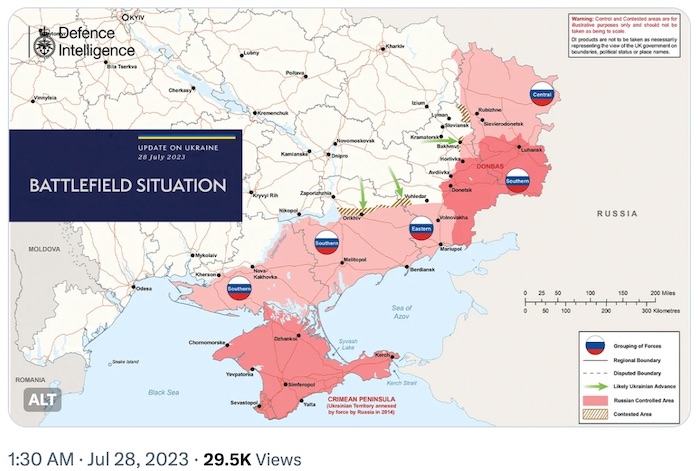
- The Russia-Africa Conference convened in St Petersburg on 27 July 2023, with 17 African heads of state attending, down from 43 at the last iteration. The event takes place ten days after Russia withdrew from the Black Sea Grain Initiative (BSGI).
- The BSGI had allowed the export of 30 million tonnes of Ukrainian grain to Africa, providing essential nutrition to states including Ethiopia, Kenya, Somalia, and Sudan. As well as the direct disruption of supplies, Russia’s blockade of Ukraine is also causing grain prices to rise.
- The impact of the war in Ukraine will almost certainly compound food insecurity across Africa for at least the next two years.
- As Ukrainian forces continue major offensive operations in Zaporizhzhia Oblast, one of the single most influential Russian weapon systems in the sector is the Ka-52 HOKUM attack helicopter. Russia has highly likely lost around forty Ka-52s since the invasion, but the type has also imposed a heavy cost on Ukraine.
- In recent months, Russia has highly likely augmented the force in the south with at least a small number of brand new, Ka-52M variants: a heavily modified aircraft, informed by lessons from Russia’s experience in Syria. Evidence supporting the M variant’s use in Ukraine includes photos posted on social media of aircrew posing next to the new aircraft and thanking well-wishers for sending them morale items.
- Another key improvement to the Ka-52 fleet is the integration of a new anti-tank missile, the LMUR, which has a range of approximately 15km. Ka-52 crews have been quick to exploit opportunities to launch these weapons beyond the range of Ukrainian air defences.
Losses of the Russian army
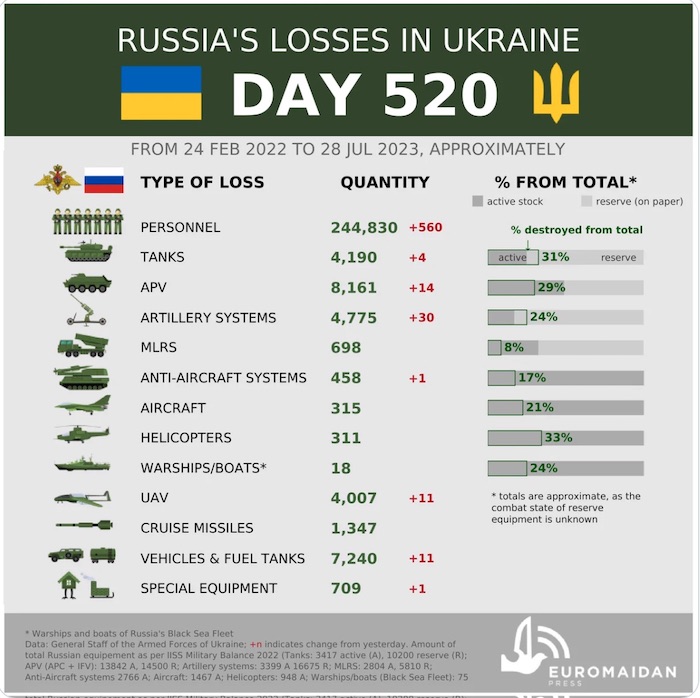
As of Friday 28 July, the approximate losses of weapons and military equipment of the Russian Armed Forces from the beginning of the invasion to the present day:
- Personnel – about 244830 (+560)
- Tanks – 4190 (+4)
- Armoured combat vehicles – 8161 (+14)
- Artillery systems – 4775 (+30)
- Multiple rocket launchers –MLRS - 698 (+0)
- Air defence means – 458 (+1)
- Aircraft - 315 (+0)
- Helicopters - 311 (+0)
- Automotive technology and fuel tanks – 7240 (+11)
- Vessels/boats - 18 (+0)
- UAV operational and tactical level – 4007 (+11)
- Special equipment – 709 (+1)
- Mobile SRBM system – 4 (+0)
- Cruise missiles – 1347 (+0)
There is panic in ranks of occupiers, there are confirmed facts of increasing desertion, - Ministry of Defense, Censor.net reports, citing Deputy Minister of Defense Hanna Maliar. “Panic moods continue to spread among the personnel of the Russian occupation forces. According to her, the vast majority of Russian servicemen who underwent training on the territory of the Republic of Belarus and at the beginning of this month were redeployed to the training grounds of the Nizhny Novgorod region, the Krasnodar region of the Russian Federation for further recovery of the losses of units of the occupying forces, are trying to avoid getting into the areas of hostilities.
There are confirmed facts of an increase in desertion, arbitrary abandonment of military units, evasion of orders, and self-mutilation to avoid being sent to the territory of Ukraine. There is an increase in "informational and explanatory work" (read intimidation) by the command of the Russian occupying forces among Russian servicemen, Maliar writes.
She also adds that threats of imprisonment and shootings are ineffective and further demotivate the personnel of the occupation units.”
Russia arrests one of its own sailors over alleged plot to attack warship, Reuters reports. “Russia has arrested one of its own sailors over an alleged plot to carry out a "terrorist attack" against a warship in Russia's Black Sea Fleet, the FSB security service said on Thursday. It said the alleged plot was directed against a ship... armed with high-precision weapons. The Black Sea Fleet is headquartered in Crimea, which Russia annexed from Ukraine in 2014.
The suspect had been recruited by a Ukrainian intelligence service and was caught with two home-made bombs, the FSB said in a statement. He was also suspected of passing state secrets to Ukraine. Russia has previously brought lesser charges, such as desertion, against some of its own servicemen. But the accusations against the sailor - which include possible charges of terrorism, treason, divulging state secrets and illegally possessing explosives, were of exceptional gravity. […]
Separately, state media quoted the FSB earlier on Thursday as saying two alleged agents for Ukrainian intelligence had been sentenced by a Russian court to 15 years each in a harsh-regime penal colony for espionage.”
Humanitarian
UN chief warns 'handful of donations' can't replace Black Sea deal, Reuters reports. “United Nations Secretary-General Antonio Guterres warned on Thursday that a handful of donations" won't correct the dramatic impact of the end of a deal that had allowed the safe Black Sea export of Ukraine grain for the past year. Global wheat prices have spiked about 10% in the past 10 days after Russia quit the pact - brokered by the United Nations and Türkiye in July 2022 - and began targeting Ukrainian ports and grain infrastructure on the Black Sea and Danube River.
It is clear that when taking out of the market millions and millions of tonnes of grains it is clear that ... will lead to higher prices, Guterres told reporters. So it's not with a handful of donations to some countries that we correct this dramatic impact that affects everybody, everywhere. Russian President Vladimir Putin on Thursday told African leaders he would gift them tens of thousands of tons of grain within months […].
Under the Black Sea grain deal, which aimed to combat a global food crisis worsened by Russia's February 2022 invasion of Ukraine, nearly 33 million tonnes of Ukraine grain was exported. Ukraine and Russia are both leading grain exporters. While global wheat prices are about half the record high hit in early March 2022 after Russia's invasion, Guterres said any increase now would be paid by everybody, everywhere - and namely by developing countries and by the vulnerable people in middle-income and even developed countries."
Ukraine: 26 port infrastructure facilities damaged in nine days of Russian strikes, Reuters reports. “Russian airstrikes have damaged 26 Ukrainian port infrastructure facilities and five civilian vessels over the course of nine days, Ukrainian Deputy Prime Minister Oleksandr Kubrakov said in a statement late on Wednesday.
Russia hit more port infrastructure in Ukraine's Odesa region in an overnight missile attack, killing a security guard and damaging a cargo terminal, the region's governor said on Thursday after Kubrakov's statement.”
There is no active discussion about warship escorts for grain from Ukraine. This will only increase tension, - Kirby, Censor.net reports, citing Suspilnе with reference to John Kirby, Strategic Communications Coordinator of the US National Security Council. “The US does not discuss the possibility of escorting ships with Ukrainian grain in the Black Sea. There is no active discussion about sending warships to the Black Sea now. This will only increase tension and increase the possibility of a potential conflict between the West and Russia, and this is not what we want. We want the grain to come out (from Ukraine to the foreign market - ed.). We want the 'grain deal' to continue and, in short, we will work with allies and partners to find other land or possibly river routes, if any are available, he said.
On July 24, The Times reported that the United Kingdom is negotiating with NATO members and other countries to send warships to the Black Sea to protect cargo ships carrying Ukrainian grain. According to the newspaper, negotiations are underway to create a so-called "coalition" of different countries that could join the British initiative. The 'coalition of the willing' will seek to break the Russian blockade in a few weeks by providing a 'protective corridor' from Odesa across the Bosporus, The Times reported.”
300 medical institutions destroyed by Russians have been fully restored - Ministry of Health, Censor.net reports, citing the website of Ministry of Health of Ukraine. “It is reported that over the 17 months of full-scale war, 1389 medical facilities have been damaged and another 186 facilities have been completely destroyed. The medical infrastructure of Kharkiv, Donetsk, Mykolaiv, Kyiv and Chernihiv regions suffered the greatest losses.
Despite constant enemy shelling and bombing, which significantly complicates the process of restoring facilities, Ukraine has already managed to restore some medical facilities. In particular, as of the end of July 2023, 343 medical facilities have been fully restored, and another 414 have been partially restored. Most of the restored medical facilities are located in Mykolaiv, Dnipro, Kyiv, Kharkiv and Chernihiv regions, the statement said.”
Legal
Russians use children in occupied territories as "human shields", - Center of National Resistance, Censor.net reports, citing the Center of National Resistance. “In the temporarily occupied territories, the Russian occupiers use civilian buildings to house their troops. In particular, civilian families with children are accommodated on the upper floors of the buildings in the hotels at the TOT of the Zaporizhzhia. At the same time, servicemen of the Russian Armed Forces are accommodated on the lower floors.
Taking cover as civilians is a common practice for Russian troops. They systematically place military equipment and personnel in sleeping areas and next to private homes of the civilian population. It is forbidden to leave the place where they place civilians, the message reads.”
Russia declares wanted International Court of Justice judge who issued warrant for Putin's arrest, Ukrainska Pravda reports. “The Ministry of Internal Affairs of the Russian Federation has announced a wanted list for Tomoko Akane, an International Criminal Court judge, who issued a warrant for the arrest of Russian President Vladimir Putin. The database of the Russian ministry says that Tomoko Akane is wanted under the article of the Criminal Code of Russia. The search card does not indicate the specific article.
Akane became the second ICC judge declared wanted in Russia. Last month, Judge Rosario Salvatore Aitala appeared in the database. In May, the Russian Interior Ministry also announced the wanted status of Karim Khan, Prosecutor of the International Criminal Court.
In March, the International Criminal Court in The Hague issued an arrest warrant for Russian President Vladimir Putin for illegally deporting thousands of children from Ukraine. The warrant means that Putin can be arrested if he goes to any member state of the International Criminal Court.”
Ukraine's Prosecutor General confirmed that the US to send evidence of Russian war crimes to the Hague, European Pravda reports. “The Ukrainian Prosecutor General stated on Twitter that the US decision represents a "historic step" towards establishing comprehensive accountability for Russia's international crimes. […] Kostin did not comment on the information that US intelligence services gathered data on Russia's war crimes in Ukraine. The New York Times said American special services gathered information, including details about the Russian officials' decision to deliberately strike Ukraine’s civilian infrastructure and to forcibly deport thousands of Ukrainian children from the occupied territory. The NYT noted the US has shared some evidence with Ukrainian prosecutors but refrained from providing it to The Hague.
Last year, the US Congress legislatively allowed the sharing of critical evidence of war crimes and intelligence with the International Criminal Court. However, the Pentagon opposes providing the International Criminal Court with evidence of Russia's war crimes in Ukraine, collected by American intelligence agencies, because they fear creating a precedent for bringing Americans to justice in the future.”
89% of Ukrainians consider corruption to be most serious problem after start of full-scale war, - KIIS survey, Censor.net reports, citing a survey of the Kyiv International Institute of Sociology. “The most serious type of corruption for Ukrainians is political corruption. The level of intolerance of paying bribes to solve personal problems has increased markedly among the general population.
Thus, 89% of respondents consider corruption to be a rather serious or very serious problem for Ukraine, second only to the full-scale invasion of Russia in the opinion of the general population and IDPs. Despite the noticeable improvement in public perception of the prevalence of corruption, 94% of respondents still believe that corruption is widespread throughout Ukraine. The percentage of those who believe that the level of corruption has increased since the beginning of the full-scale war exceeds the percentage of those who believe that it has decreased, and thus society remains very divided on the assessment of this issue. According to 53% of respondents, such actions can never be justified, compared to 42% in 2018 and 2021..”
Ukraine's Parliament Passed Law on Selection of Judges for Constitutional Court Needed for Opening EU Accession Negotiations, European Pravda reports. “The Verkhovna Rada has adopted the draft law No. 9322 in the second reading. It introduces changes to the procedure for selecting judges of the Constitutional Court, in order to meet the criteria by the European Commission on Ukraine's EU accession. As MP Yaroslav Zhelezniak reported on Telegram, 293 members of parliament supported the law. […]
According to him, the document includes a provision that strengthens the role of international experts in the selection of judges: If the Advisory Group of Experts cannot make a decision due to an equal number of votes 'for' and 'against,' a repeated voting takes place. In case of an equal number of votes 'for' and 'against' during such a repeated voting, the votes of three members of the Advisory Group of Experts, at least two of whom are nominated by international organisations or the European Commission 'For Democracy through Law,' are decisive, the draft law states. […]
The reform of the system for selecting judges of the Constitutional Court is one of the seven criteria set by the European Commission. Their fulfillment is necessary for opening EU accession negotiations. On June 9, G7 ambassadors presented key recommendations for Ukraine to strengthen anti-corruption institutions and reform the judicial system. One of the recommendations pertains to the introduction of legislation for a transparent selection of judges for the Constitutional Court of Ukraine based on meritocracy.”
Support
US plans to start delivering Abrams tanks to Ukraine in Sept, Ukrinform reports, citing to Politico, which refers to six people familiar with the planning. “US-made Abrams tanks are likely to arrive on the Ukrainian battlefield in September. The plan is to send a handful of Abrams tanks to Germany in August, where they will undergo final refurbishments. Once that process is complete, the first batch of Abrams will be shipped to Ukraine the following month. The US is sending older M1A1 models instead of the more modern A2 version, which would have taken a year to get to Ukraine.
A Department of Defense official and another person familiar with Kyiv's thinking said the tanks could even arrive in Ukraine as early as August, but that timeline may be overly optimistic. The tanks are not new; instead, the older vehicles are being stripped of their most sensitive technology, including in some cases secret depleted uranium armor, before they can be sent to Ukraine.
The initial batch will involve six to eight tanks. In total the US is planning to send 31 tanks, a Ukrainian battalion's worth. Before Ukrainian forces can begin operating the tanks, they have to wrap up a roughly 10-week course on 31 trainer tanks at the Grafenwoehr Army base in Germany.
The US is working with its European allies to establish heavy maintenance repair facilities, especially for battle damage to the Abrams tanks and other heavy armor that has been donated to Ukraine.”
Ukrainian pilots will be trained on F-16 in Romania and Denmark, - Kirby, Censor.net reports, citing RBC-Ukraine with reference to Briefing by White House National Security Council Coordinator John Kirby. “Ukrainian pilots will be trained under the F-16 program in Romania and Denmark. Dates, places, duration of the program, all this is still in the process of development, Kirby said.
He added that in addition to Romania and Denmark, Ukrainian pilots could also be trained on the F-16 in other places. Kirby noted that the British are starting to train pilots in English so that they can fly American fighters.”
McConnell, leader of Republicans in US Senate, called on government to speed up supply of weapons to Ukraine, Censor.net reports, citing European Pravda. “The leader of the Republican Party in the US Senate, Mitchell McConnell, called on the Biden administration to provide Ukraine with the weapons it needs in the fight against Russian aggression as soon as possible. […] He emphasized that the Biden administration must start moving at the appropriate speed to provide Ukraine with the lethal tools they need to end their struggle.
For its part, as we work to ensure common defence, the Senate must invest in a defence industrial base that can ensure America's support for Ukraine while arming our own forces to deter further threats from Russia and China, McConnell noted. According to him, the indecision and inaction of the Biden administration are causing some key forces and defence assets to arrive late on the battlefield.
McConnell also recalled the need to provide Ukraine with long-range missiles, saying that "long-range strikes would help Ukraine force the Russian occupiers to retreat, as our friends have already demonstrated with the successful use of British Storm Shadow cruise missiles."
Ukraine received about $27B from international partners since early 2023, Ukrinform reports. “Ukraine has received about $27 billion from international partners since the beginning of 2023. The relevant statement was made by National Bank of Ukraine (NBU) Governor Andriy Pyshnyy at a briefing.
Since the beginning of the year, Ukraine has received about $27 billion from international partners, which significantly exceeds the amount of the NBU’s foreign currency sales intended to balance the foreign exchange market,” Pyshnyy said.
In his words, thanks to the rhythmic inflow of international aid, Ukraine’s foreign exchange reserves reached $39 billion at the end of June 2023. The international support allowed the Ukrainian government to cover a significant budget deficit without resorting to monetary financing. A reminder that Ukraine expects to receive $42 billion in financial assistance in 2023, including $4.6 billion from the International Monetary Fund (IMF).”
Government transferred UAH 672 billion to army in six months, - Shmyhal, Censor.net reports, citing Ukrinform. “I want to note that in the first half of the year, the Ukrainian budget received a little more than UAH 600 billion. This is a large indicator, it is actually an indicator of peacetime, despite the loss of the economy. But we transferred UAH 672 billion [$ 18.9 billion] to the army. These are funds that we attract on market terms, funds that we attract from partners, the head of government said. According to Shmyhal, Ukrainian business taxes go to support the Armed Forces of Ukraine.”
New developments
- Ukrainian parliament extends martial law and mobilisation, Ukrainska Pravda reports, citing lawmaker Yaroslav Zhelezniak on Telegram and draft law 9532. “The Verkhovna Rada [Ukrainian parliament] has approved a draft law extending martial law and general mobilisation by another 90 days. Martial law and general mobilisation were extended until 15 November 2023.”
- Putin promises African leaders free grain despite 'hypocritical' Western sanctions, Reuters reports. “Russian President Vladimir Putin on Thursday told African leaders he would gift them tens of thousands of tons of grain despite Western sanctions, which he said made it harder for Moscow to export its grain and fertilisers. Speaking at a Russia-Africa summit in St Petersburg, Putin said Russia was ready to replace Ukrainian grain exports to Africa on both a commercial and aid basis to fulfil what he said was Moscow's critical role in global food security. We will be ready to provide Burkina Faso, Zimbabwe, Mali, Somalia, Central African Republic and Eritrea with 25-50,000 tonnes of free grain each in the next three to four months, Putin told the summit, whose participants applauded. […] UN chief Antonio Guterres called the promised grain "a handful of donations".
- Zelensky advises Russians leave Crimea while Kerch Bridge is somehow still functioning, Ukrainska Pravda reports. “Zelenskyy says Russian occupiers should consider returning home to Russia from the Ukrainian peninsula as long as the Crimean Bridge is still functioning. Crimea, like all of Ukraine, will be free – free from all Russian evil, starting with Russian missiles and ending with every Russian occupier. Russia will lose this war, and no missile will save it, the president said.”
- Belarus-EU borders may be closed if Wagner group incidents happen, Poland says, Reuters reports. “Poland, Lithuania and Latvia could jointly decide to shut their borders with close Russian ally Belarus if there are serious incidents involving the Wagner group along their frontiers with the country, Poland's Interior Minister said on Thursday. NATO member Poland on July 19 decided to move military units to its east after Wagner mercenaries began training Belarusian special forces a few miles from its border. Two days later President Vladimir Putin accused Poland of having territorial ambitions in the former Soviet Union, and said any aggression against Belarus would be considered an attack on Russia.”
- China supplies Russia with technology it uses in war against Ukraine – US intelligence, Ukrainska Pravda reports, citing an unclassified assessment by the Office of the Director of National Intelligence (ODNI). “The US intelligence has found out that China is supplying Russia with military technologies that Russia uses in the war against Ukraine. The US National Intelligence said that The PRC is providing some dual-use technology that Moscow’s military uses to continue the war in Ukraine, despite an international cordon of sanctions and export controls. The customs records show PRC state-owned defence companies shipping navigation equipment, jamming technology, and fighter-jet parts to sanctioned Russian Government-owned defence companies."
Assessment
- On the War
The Institute for the Study of War has made the following assessment as of Thursday 27 July:
“Russian forces continued offensive operations west of Svatove and made claimed gains on July 27. The Ukrainian General Staff reported that Russian troops conducted unsuccessful offensive actions near Nadiya (14km southwest of Svatove) and south of Novoselivske (16km northwest of Svatove). The Russian Ministry of Defense (MoD) claimed that elements of the 7th Motorized Rifle Regiment (11th Army Corps, Baltic Fleet) captured unspecified advantageous positions west of Kuzemivka (13km northwest of Svatove). The Russian MoD also claimed that elements of the Russian Central Grouping of Forces advanced 12km along the front and penetrated 3km deep into Ukrainian defensive lines near Serhiivka (12km southwest of Svatove). One Russian milblogger claimed that Russian forces continue to advance west of Svatove towards the Oskil River at a pace of 1km a day. ISW has not yet observed visual confirmation to suggest that Russian forces are advancing at a pace near 1km a day on the Svatove sector. ISW has not observed visual confirmation of recent Russian claims of extensive advances southwest of Svatove, and the Russian MoD may be exaggerating claims of advances to draw attention away from Ukrainian counteroffensives elsewhere along the front.
Russian forces continued offensive operations west of Kreminna and made claimed gains on July 27. The Ukrainian General Staff reported that Russian forces unsuccessfully attacked in the area south of Dibrova (5km southwest of Kreminna). Russian milbloggers claimed that Russian troops also continued fighting in the Serebryanske forest area southwest of Kreminna and broke through Ukrainian defensive lines in an unspecified part of the forest area.
The Russian MoD claimed that Ukrainian forces conducted an unsuccessful limited attack west of Kreminna on July 27.
Ukrainian forces continued counteroffensive operations in the Bakhmut area on July 27 and have made recent marginal advances in the area. Geolocated footage published on July 26 indicates that Ukrainian forces made marginal advances north of Klishchiivka (7km southwest of Bakhmut). The Ukrainian General Staff reported that Ukrainian forces continued offensive operations north and south of Bakhmut. Russian sources claimed that Ukrainian forces conducted assaults near Zaliznyanske (12km north of Bakhmut), Berkhivka (4km north of Bakhmut), Klishchiivka, Andriivka (10km southwest of Bakhmut), and Pivnichne (20km southwest of Bakhmut). Russian sources claimed that Russian forces completely control Klishchiivka as of the morning of July 27 and that Ukrainian forces failed to hold positions in the settlement. Some Russian milbloggers claimed that Ukrainian forces maintain a presence in the southern part of Klishchiivka and continue attempts to liberate the settlement. ISW has observed recent geolocated footage indicating that Ukrainian forces have recently made tactically significant gains south of Klishchiivka and maintain a presence in the southwestern part of the settlement.
Russian forces counterattacked around Bakhmut on July 27 but did not make any confirmed gains. The Ukrainian General Staff reported that Ukrainian forces repelled Russian assaults north of Khromove (immediately west of Bakhmut), north and south of Klishchiivka, and east of Druzhba (19km southwest of Bakhmut). Russian sources claimed that Russian forces also counterattacked near Orikhovo-Vasylivka (11km northwest of Bakhmut) and Kurdyumivka (12km southwest of Bakhmut).
Russian sources claimed that Ukrainian forces conducted limited ground attacks along the Avdiivka-Donetsk City front on July 27 without advancing. The Russian Ministry of Defense (MoD) claimed that Russian elements of the Southern Grouping of Forces repelled Ukrainian assaults near Avdiivka and Marinka (27km southwest of Avdiivka). Russian milbloggers amplified footage on July 27 purporting to show elements of the Donetsk People’s Republic (DNR) 110th Separate Motorized Rifle Brigade (1st Army Corps) repelling a Ukrainian assault near Nevelske (13km southwest of Avdiivka).
Russian forces continued ground attacks along the Avdiivka–Donetsk City front on July 27 but did not make any confirmed gains. The Ukrainian General Staff reported that Russian forces conducted unsuccessful offensive operations near Avdiivka and Marinka. Ukrainian Deputy Defense Minister Hanna Maliar stated on July 26 that Russian forces continue attempts to encircle Avdiivka and that fighting in the Avdiivka area is as intense as combat engagements in the Bakhmut direction. A Russian milblogger claimed that elements of the DNR “Pyatnashka” International Brigade can now fully interdict remaining Ukrainian ground lines of communication (GLOC) in the Avdiivka area. Russian milbloggers routinely claimed in the winter and spring of 2023 that Russian forces had fire control over Ukrainian GLOCs around Bakhmut long before they likely did, and there are no indications that Russian forces are interdicting all Ukrainian GLOCs in the Avdiivka area.
Ukrainian forces continued offensive operations along the Donetsk-Zaporizhzhia Oblast border and advanced on July 27. Ukrainian President Volodymyr Zelensky posted footage on July 27 showing that Ukrainian forces liberated Staromayorske (9km south of Velyka Novosilka) following heavy fighting in the area. The Ukrainian General Staff also acknowledged unspecified Ukrainian advances near Staromayorske earlier on July 27. Russian milbloggers claimed overnight on July 26 and on the morning of July 27 that Ukrainian forces retained positions on the northern outskirts of Staromayorske and continued pushing into the village itself from the north and northwest. The Russian Ministry of Defense (MoD) claimed that Russian forces repelled a Ukrainian ground attack near Urozhaine (9km south of Velyka Novosilka). Some Russian milbloggers claimed that Ukrainian forces conducted unsuccessful ground attacks near Pryyutne (15km southwest of Velyka Novosilka) on July 26 and Novodonetske (12km southeast of Velyka Novosilka) on July 27. Some Russian sources, including the commander of the “Vostok” battalion defending in the area, Alexander Khodakovsky, expressed continued concern about Russia’s ability to hold Urozhaine.
Russian forces conducted limited offensive operations in the Donetsk–Zaporizhzhia Oblast border area and did not advance on July 27. The Ukrainian General Staff reported that Russian forces conducted unsuccessful ground attacks to recapture lost positions near Staromayorske.
Ukrainian forces continued offensive operations in western Zaporizhzhia Oblast on July 27 on a smaller scale than their July 26 operations and likely advanced in the area. Geolocated footage published on July 26 suggests that Ukrainian forces made additional advances east of Robotyne (10km south of Orikhiv) during offensive operations on July 26. The Ukrainian National Guard Main Command Department of Application Planning’s Acting Director Mykola Urshalovych stated that Ukrainian forces made unspecified significant advances in the Melitopol direction on July 27. The Russian MoD and some prominent Russian milbloggers claimed that Ukrainian forces of up to three battalion tactical groups (BTGs) conducted unsuccessful offensive operations near Robotyne overnight on July 26 and did not attack further in the morning. Other Russian milbloggers claimed that Ukrainian forces continued multiple waves of ground attacks overnight on July 26 and during the day on July 27, sustaining heavy equipment and personnel losses. Some milbloggers claimed that Ukrainian forces advanced towards Robotyne while others claimed that Russian forces repelled all the attacks. One Russian milblogger claimed that Ukrainian forces advanced to within 800-1,000 meters of Robotyne overnight before Russian forces stopped the Ukrainian advance. Russian milbloggers claimed that Ukrainian forces also attacked Zherebyanky (26km southwest of Orikhiv) overnight.
Ukrainian forces have likely advanced further in western Zaporizhzhia Oblast than ISW has been able to visually confirm so far. Geolocated footage published on July 27 shows that a single Ukrainian armored vehicle reached Russian anti-tank positions northwest of Verbove (17km southeast of Orikhiv), roughly 3.5 kilometers beyond ISW’s currently assessed frontline. It is unclear why a lone Ukrainian armored vehicle approached Russian defensive positions without additional forces in support. The fact that this lone Ukrainian vehicle advanced so far towards Russian defensive lines apparently without suffering Russian fire suggests that Ukrainian forces may have made advances in the surrounding area southeast of Orikhiv of which ISW has not yet observed visual confirmation.
Russian and occupation authorities continue to struggle with flowing logistics into occupied southern Ukraine through Crimea. The Russian Federal Security Service (FSB) announced on July 27 that it is suspending civilian entry to the Arabat Spit as of 2000 local time on July 31 for an indeterminate period of time to “localize security issues.” The FSB stated that only emergency responders and defense workers can enter the Arabat Spit under the order. Russian and occupation authorities may be attempting to limit civilian entry to the Arabat Spit to allow for broader efforts to restore the road connecting the spit to occupied Kherson Oblast and Crimea as a reliable ground line of communication (GLOC) to support Russian forces in southern Ukraine. Russian occupation authorities temporarily suspended civilian traffic across the Kerch Strait Bridge from Kerch, occupied Ukraine to Russia overnight on July 26–27, the latest in a wave of suspensions that may indicate continued trouble with security or traffic across the bridge as Russian authorities work to restore it.
Russian authorities continue efforts to posture militarily in the Black Sea to possibly set conditions for a blockade or some lesser maritime interdiction campaign against Ukraine. The FSB claimed on July 27 that it arrested a Russian sailor for allegedly working with Ukrainian intelligence to conduct a “terrorist attack” on an unspecified Russian vessel carrying high-precision missiles. The FSB claimed that it identified explosives on another unspecified vessel headed from Türkiye towards Rostov-on-Don on July 26. Russian authorities are likely attempting to portray Ukraine as willing to use sabotage and civilian cargo ships to attack Russian naval and other military assets.
Ukrainian forces continued counteroffensive operations on at least three sectors of the front on July 27 and made gains in some areas, although Ukrainian forces appear not to have continued significant mechanized assaults south of Orikhiv in western Zaporizhzhia Oblast. Ukrainian President Volodymyr Zelensky posted footage on July 27 showing that Ukrainian forces liberated Staromayorske (9km south of Velyka Novosilka) in western Donetsk Oblast following heavy fighting in the area. Geolocated footage published on July 26 indicates that Ukrainian forces also made marginal advances north of Klishchiivka (7km southwest of Bakhmut). Geolocated footage published on July 26 suggests that Ukrainian forces made additional advances east of Robotyne (10km south of Orikhiv) during offensive operations on July 26. Ukrainian Director of the Department of Application Planning at the Main Command of the National Guard Mykola Urshalovych stated on July 27 that Ukrainian forces achieved tactical victories in the Melitopol direction (western Zaporizhzhia Oblast). Russian sources claimed that Ukrainian forces continued assaults at a lower tempo and with far less manpower near Robotyne on July 27 after Ukrainian forces launched an intense mechanized frontal assault that broke through Russian defensive positions northeast of the settlement on July 26. Geolocated footage published on July 27 suggests that Ukrainian forces may be operating in areas well forward of where ISW assesses Ukrainian advances to be as a result of ISW’s intentionally conservative assessments about control of terrain (covered in more detail in Southern Axis text).
The Kremlin and the wider Russian information space are intensifying efforts to portray the Ukrainian counteroffensive as a failed effort. Russian President Vladimir Putin stated to a reporter on July 27 that in recent days Russian forces destroyed 39 armored vehicles out of 50 that Ukrainian forces committed to intensified assaults in the Zaporizhzhia direction. Putin claimed that Russian forces also killed 60 percent of the Ukrainian personnel that conducted these assaults as well as 40 percent of Ukrainian combat aviation pilots in the area. Putin has previously claimed that Russian forces have destroyed an implausible amount of Ukrainian equipment during Ukrainian counteroffensive operations, although his figures concerning Ukrainian assaults in recent days indicate an inflection in his exaggeration of likely Ukrainian losses. Russian milbloggers similarly claimed that Russian forces destroyed dozens of Ukrainian armored vehicles and celebrated the alleged losses as proof that the Ukrainian counteroffensive is stalling. The Kremlin’s and the Russian information space’s framing of the Ukrainian counteroffensive notably violates a reported Kremlin manual instructing Russian media not to downplay the potential for successful Ukrainian counteroffensive operations. The intensifying portrayal of the Ukrainian counteroffensive as a failed effort suggests that the Kremlin’s policy on the coverage of the war is to bolster efforts to promote itself as an effective manager of the war effort.
A US official expressed caution about assessing that the July 26 uptick in Ukrainian counteroffensive operations in western Zaporizhzhia Oblast is part of the Ukrainian main effort, tempering July 26 statements to the contrary. The Washington Post cited an unspecified US official as saying that Ukrainian counteroffensive operations in the Zaporizhzhia direction may be shaping operations for a later counteroffensive effort, but that US officials do not assess that these operations are part of Ukraine’s main effort. CNN cited two US officials as saying that Ukrainian forces have deployed the “main bulk” of their reserve forces to southern Ukraine to capitalize on recent Ukrainian gains. UK Minister for the State of the Armed Forces James Heappey stated that Ukrainian forces are being “appropriately cautious” and are meeting current expectations.
Russian President Vladimir Putin used the Russia–Africa Economic and Humanitarian Forum in St. Petersburg on July 27 to continue efforts to posture Russia as a more attractive ally to African partner states than the collective West. Putin met with several African leaders at the forum, including Ugandan President Yoweri Kaguta Museveni, President of Zimbabwe Emmerson Dambuzo Mnangagwa, President of the Republic of Burundi Evariste Ndayishimiye, President of Mozambique Filipe Jacinto Nyusi, and President of Comoros Azali Assoumani. During his speech at the plenary session of the forum, Putin emphasized the importance of expanding Russian–African cooperation and Russia’s investment in the development of African nations, notably accusing Ukraine and the West of interfering with Russia’s supply of grain and fertilizers to the African continent and claiming that Russia will provide between 25 and 50 thousand tons of grain free of charge to Burkina Faso, Zimbabwe, Mali, Somali, Central African Republic, and Eritrea over the coming months. Putin announced that Russia is helping to develop over 30 energy infrastructure projects in 16 African states and called for an expansion of cultural and social integration between Russia and the African continent, stating that Russia plans to open branches of Russian universities in Africa and increase enrollment of African students in Russian educational institutions.
Beyond the typical diplomatic platitudes and promises of continued cooperation and development, Putin’s rhetoric during the Russia-Africa forum does not represent a major inflection in the Kremlin’s policy toward the African continent. Putin previously signed an article published on July 24 to posture Russia’s commitment to African development and mitigate damage done to Russia’s position in Africa and his personal reputation with African leaders. Putin’s and the Russian government’s reputations likely suffered due to a number of recent factors: Russia’s recent withdrawal from the Black Sea Grain Initiative and strikes on Ukrainian port infrastructure (both of which were critical for grain exports to various African countries) and his inability to attend the upcoming BRICS summit because of the International Criminal Court’s (ICC) arrest warrant against him.
Wagner Group financier Yevgeny Prigozhin was also present in St. Petersburg on July 27 and took the opportunity to informally meet with an unknown number of African leaders, suggesting that the Wagner Group intends to remain a significant player in Africa. Russian milbloggers amplified photos of Prigozhin shaking hands with a Central African Republic official and the “director of Afrique media.” A Russian insider source claimed that Prigozhin held private, informal meetings with representatives of an unknown number of African governments in a hotel close to the Russia–Africa Economic and Humanitarian Forum but did not attend the summit itself. Prigozhin's continued efforts to meet with and message to African leaders are likely part of Wagner's efforts to maintain its profitable military and mining contracts in Africa. An unnamed Wagner commander who recently returned from CAR claimed on July 26 that Wagner is working on increasing its operations in Africa to fund its presence in Belarus. Prigozhin additionally used the backdrop of the Russia-Africa summit to position Wagner as a viable anti-Western partner for post-coup Niger. Wagner-affiliated Telegram channels began circulating an audio recording reportedly of Prigozhin on July 27 wherein Prigozhin praised the Nigerien military’s removal of Nigerien President Mohamed Bazoum and lauded it as an act of “gaining independence,” while accusing Western nations of deliberately destabilizing the situation in Africa and supporting terrorist organizations. Prigozhin suggested that a “thousand fighters” from Wagner would be able to restore order, presumably in post-coup Niger. Several Russian milbloggers responded to Prigozhin’s purported audio recording and suggested that Niger will need “help” from Wagner similar to what Mali needed following its coup in May 2021. Prigozhin is posturing Wagner as a viable security partner for Niger, which is largely consistent with ISW’s and the Critical Threats Project’s (CTP) previous assessment that Wagner is likely to maintain and even expand its presence in the African continent following its July 24 armed rebellion.
The Kremlin reportedly distributed a manual to Russian state media on framing the anniversary of the Baptism of Rus on July 28, likely as part of continued information operations and propaganda narratives to advance Russian military objectives. Russian opposition news outlet Meduza reported on July 27 that it obtained the manual but did not publish the manual itself, which reportedly directs Russian state media to frame the Baptism of Rus as “a key turning point in Russian history” and “the point of formation of statehood.” The manual reportedly emphasized that a “common faith” allowed the “East Slavic tribes” to unify as “one people.” The manual reportedly instructs state media to paint Russian President Vladimir Putin as the one who “brought the mission of defending the Orthodox faith back to Russia” and reportedly labels the Ukrainian government an “apostate regime” and a “satanic regime” that is trying to “destroy” Orthodoxy in Ukraine and “the spiritual ties of the fraternal peoples.” These Kremlin-dictated religion-based narratives come as Russia is itself committing systematic religious repressions and persecutions throughout Ukraine, including against Orthodox Christians, in an effort to destroy Ukrainian cultural and national identity. The Kremlin reportedly issued a similar manual to state media in May aimed at controlling the narratives about a potential upcoming Ukrainian counteroffensive, and the distribution of these manuals demonstrates the Kremlin’s use of various information operations to spread propaganda messages and discredit Ukraine in the international arena. […]
Key Takeaways:
- Ukrainian forces continued counteroffensive operations on at least three sectors of the front on July 27 and made gains in some areas, although Ukrainian forces appear not to have continued significant mechanized assaults south of Orikhiv in western Zaporizhzhia Oblast.
- A US official expressed caution about assessing that the July 26 uptick in Ukrainian counteroffensive operations in western Zaporizhzhia Oblast is part of the Ukrainian main effort, tempering July 26 statements to the contrary.
- Russian President Vladimir Putin used the Russia–Africa Economic and Humanitarian Forum in St. Petersburg on July 27 to continue efforts to posture Russia as a more attractive ally to African partner states than the collective West.
- Wagner Group financier Yevgeny Prigozhin was also present in St. Petersburg on July 27 and took the opportunity to informally meet with an unknown number of African leaders, suggesting that the Wagner Group intends to remain a significant player in Africa.
- Prigozhin additionally used the backdrop of the Russia-Africa summit to position Wagner as a viable anti-Western partner for post-coup Niger.
- The Kremlin reportedly distributed a manual to Russian state media on framing the anniversary of the Baptism of Rus on July 28, likely as part of continued information operations and propaganda narratives to advance Russian military objectives.
- Russia conducted another strike on Ukrainian port infrastructure in Odesa Oblast and rear areas of Ukraine overnight on July 26–27.
- Russian forces conducted offensive operations along the Kupiansk-Svatove-Kreminna line, in Bakhmut, along the Avdiivka-Donetsk City line, and in the Donetsk-Zaporizhzhia Oblast border area on July 27 and did not make any confirmed advances.
- Ukrainian forces continued counteroffensive operations on at least three sectors of the front on July 27 and have advanced south of Bakhmut, in the Zaporizhzhia-Donetsk Oblast border area, and in western Zaporizhzhia Oblast.
- The Russian State Duma approved measures on July 27 aimed at clarifying confusion surrounding the recently updated laws regarding conscripts and reservists.
- Russian authorities are discriminating against Ukrainian refugees in Belgorod Oblast, Russia.“
Main strike of Ukraine's counteroffensive to be landed in Zaporizhzhia front – NYT, Ukrainska Pravda reports, citing New York Times with reference to US anonymous officials. “The Ukrainian military command has informed Washington of a new phase of the Defence Forces' counter-offensive. The New York Times noted that Ukrainian officials had told US officials that reinforced Ukrainian groups would attempt to advance south through Russian minefields and other fortifications to the city of Tokmak, and, if successful, to Melitopol.
Their goal is to break the so-called land bridge between the Russian-occupied Ukrainian territories and the Crimean peninsula, or at least advance far enough to put the strategically important peninsula within range of Ukrainian artillery. […] The new Defence Forces operation, if successful, could take one to three weeks, Ukrainian officials told Washington.
However, little has gone according to plan since the counteroffensive began in early June, and officials at the White House and Pentagon said on Wednesday that they were watching the increased activity with great interest. This is the big test, one US official said.
The main strike of Ukraine's nearly two-month-long counteroffensive is the country's southeast, where thousands of reinforcements, many trained and equipped by the West and until now held in reserve, are pouring into the fierce battle, two Pentagon officials said on Wednesday. Overall, the Zaporizhzhia front is one of the three axes of the Ukrainian counter-offensive. One of Ukraine's military goals is to reach the Sea of Azov, driving a wedge between the Russian-occupied territories in southern and eastern Ukraine.”
Ukraine ramps up counteroffensive after months of slow progress – CNN, Censor.net reports, citing CNN. “Ukraine is likely to increase the pace of its counter-offensive after two months of slow progress on the battlefield. Two US officials told the newspaper that Ukraine has moved additional forces to the southeast of the country, indicating that Kyiv has identified potential weaknesses in Russian defence lines. The Ukrainian military has maintained a large number of trained troops, some equipped with more powerful Western weapons, since the start of the operation in early June. While it still maintains some combat power in reserve, it has now deployed the 'bulk' of the forces involved in the counter-offensive, the article says.
According to the newspaper, the counteroffensive appears to have yielded some results. The counterattack has broken through some elements of Russian defensive lines in the southeast, and reserve units have moved in to take advantage of this opportunity. A Russian military official acknowledged that Ukrainian troops managed to 'break in' on three sections of Russia's first line of defence on the Zaporizhzhia frontline on Wednesday, CNN writes.
The 47th Brigade of the Ukrainian Armed Forces, which is taking part in the offensive, confirmed to CNN that it was advancing, saying: Infantry is advancing. Artillery is covering. Bradley crews are destroying enemy infantry and their equipment."
UK Ministry of Defence believes Ukrainian counteroffensive goes according to plan, Ukrainska Pravda reports, citing James Heappey, the Minister of State for the Armed Forces at the UK Ministry of Defence, in an interview for The Telegraph. “The UK Ministry of Defence has dismissed concerns about the slow pace of the counteroffensive of the Ukrainian Defence Forces, saying that operations are going according to plan. He said the counteroffensive of Ukraine is taking place according to the plan developed jointly with the United Kingdom and the United States in the winter.
The minister noted that Kyiv is showing appropriate caution, refusing to send a large number of people and Western weapons through dense Russian minefields. He added that the Ukrainian military retains sufficient firepower to make a breakthrough at the right moment.
Ukraine is meeting our expectations at the moment. They are broadly delivering the plan that they worked out with us, and the Americans and others, over the last winter. This is not a Hollywood movie. There was not going to be a moment when the tanks started to roll, and the music started to play, and a war montage played out and then – at the end of it – victory by September."
Despite minefields and other obstacles, Ukraine has enough opportunities to continue counteroffensive against Russian army, - Austin, Censor.net reports, citing CNN. “US Defense Secretary Lloyd Austin said that Ukraine is well prepared to continue counteroffensive operations against Russian troops. The head of the Pentagon did not comment on the course of the counteroffensive or specific details of the fighting but said that Ukraine retains manpower and equipment even though its troops are forced to make their way through minefields and other obstacles.
They still have several options available, and we can expect them to continue to push, Austin noted. According to him, Ukraine is well prepared to achieve success on the battlefield. They fought hard, they worked to get through minefields and other obstacles, but they still have a lot of fighting power, the defence minister added.”
- Consequences and what to do?
ME: NATO warns of new risks for escalation after Moscow pulled out of the Black Sea Grain Initiative. Russia has announced that it will deem all ships heading for Ukrainian waters from to be potentially carrying weapons, and their flag countries as parties to the war on the Ukrainian side.
Immediate after the collapse of the Black Sea Grain Initiative Russian on July 17, Russian and Ukrainian authorities issued separate navigational warnings to shipping in the northern Black Sea. International maritime law states that vessels suspected of carrying military equipment may be boarded and searched, and civilian vessels belonging to the opposing side may be seized. Attacks against civilian shipping, however, are illegal in most cases.
According to the White House, Russia is believed to have laid additional sea mines in the approaches to Ukrainian ports. Since terminating the grain agreement, Russia has started relentless attacks against Ukrainian ports. Massive missile and UAV strikes have damaged more than 26 Ukrainian port infrastructure facilities and five civilian vessels during the last 10 days alone.
The Alliance notes that Russia’s new warning area in the Black Sea, within Bulgaria’s exclusive economic zone, has created new risks for miscalculation and escalation, as well as serious impediments to freedom of navigation. It said it was declaring parts of the Black Sea to be unsafe.
“Secretary General Jens Stoltenberg said: “Russia bears full responsibility for its dangerous and escalatory actions in the Black Sea region. Russia must stop weaponising hunger, and threatening the world’s most vulnerable people with food instability. Russia’s actions also pose substantial risks to the stability of the Black Sea region, which is of strategic importance to NATO. Allies are stepping up support to Ukraine and increasing our vigilance.”
After a meeting of the NATO-Ukraine Council on Wednesday, NATO announced that the Alliance and Allies are stepping up surveillance and reconnaissance in the Black Sea region, including with maritime patrol aircraft and drones. Its response, however, fell short of deploying any of its standing maritime groups to the Black Sea to clear mines, ensure Freedom of Navigation and escort civilian vessels.
The decision not to deploy maritime forces into theatre came amidst Russian signalling.
According to the UK Defence Intelligence, Russia’s Black Sea Fleet has altered its posture since Russia pulled out of the Black Sea Grain Initiative. A corvette has deployed to the southern Black Sea, patrolling the shipping lane between the Bosporus and Odesa. While it is believed that it will form part of a task group tasked to intercept commercial vessels heading to Ukraine, it must also be seen as a signal to NATO as the Alliance is considering its military options. The maritime embargo of Ukraine has been ongoing since before the full-scale invasion started on 24 February 2022. Any change to the Black Sea Fleet posture is more likely linked to ongoing Western discussions to start escorting civilian vessels bound for Ukraine.
“The issue of transit of ships in the Black Sea will be discussed during a possible future meeting between Presidents of Russia and Turkiye, Vladimir Putin and Recep Tayyip Erdogan, Russian Deputy Foreign Minister Sergey Vershinin said. The idea that Turkish ships could escort Ukrainian grain supplies in the Black Sea is impossible and dangerous, Russian Deputy Foreign Minister Sergey Vershinin said on Friday."
According to John Kirby, the Strategic Communications Coordinator of the US National Security Council. “The US does not discuss the possibility of escorting ships with Ukrainian grain in the Black Sea. There is no active discussion about sending warships to the Black Sea now. This will only increase tension and increase the possibility of a potential conflict between the West and Russia, and this is not what we want.”
The statement means that the US is also blocking NATO from deploying its maritime forces into the Black Sea.
The US decision to remain disengaged is odd given the nature of the task. Protecting humanitarian shipping does not constitute a threat to the Russian Federation. A maritime task force would be tasked to uphold international law: Freedom of Navigation and the protection of humanitarian shipping in conflict zones.
The present US policy is, however, also at odds with its past actions when its national interests are threatened.
Media reports, however, that the United Kingdom is negotiating with other countries to form a coalition of the willing that might send warships to the Black Sea to break the maritime embargo.
In the article “NATO Convoys Can Protect Ukraine’s Grain Harvest From Putin” in The Washington Post, Admiral James Stavridis, USN (Ret.), argues that the Russian maritime blockade is illegal under international law. A state of war has not been declared. The blockade limits the universal freedom of navigation on the high seas. Additionally, Putin is also weaponizing hunger by cutting global food supplies.
He argues in favour of establishing convoys in the Black Sea under the broad provisions of international law that permit enforcing the freedom of international waters and allow the protection of humanitarian shipping in conflict zones. Since the UN is rendered unable to take a lead role because of Russia’s veto right he argues that the mission should be undertaken either by NATO or by a “coalition of the willing” led by the US.
Since the US is unwilling to deploy the US Navy out of fear of a broader confrontation, we must put our hope in the United Kingdom taking the lead of a European coalition of the willing.
Europe has enough destroyers, frigates and minesweepers/-hunters to form the two maritime tasks forces needed to solve the mission. Additionally, the maritime force would need air cover and air surveillance.
A coalition of the willing might consider establishing a Maritime Exclusion Zone to constrain the movements of the Russian Black Sea Fleet and the flight of its maritime aviation to avoid accidents and aggressive manoeuvres at close encounters.
It should also establish a route through territorial waters of Türkiye, Bulgaria and Romania to reduce the likelihood of Russian and European Armed Forces operating close to each other’s.
For the grain transport to continue, however, Ukraine also urgently needs Air Defence to protect its ports and infrastructure. Vessels entering Ukrainian ports needs proper protection. The West urgently needs to step up its delivery of the much-needed air defence means. Additionally, stationing Western warships outside Ukrainian ports and territorial waters might help reduce the threat from Russian missiles and UAVs.
Will Europe be able to establish a maritime coalition of the willing?
Maybe. But it will be an uphill battle. Türkiye has already declined a Ukrainian request for it to escort civilian vessels in the Black Sea. It is balancing its national interests with Russian demands and Ukrainian requests. Germany has until now, not demonstrated any will to confront Russia. France will join a British endeavour if it finds it to be in its national interest to do so. Bulgaria is not likely to join the endeavour given its relationship with Russia. The other maritime NATO member states – Albania, Belgium, Canada, Denmark, Estonia, Finland, Greece, Italy, Latvia, Lithuania, Montenegro, Netherlands, Norway, Poland, Portugal, Romania, and Spain - has various maritime capabilities altogether. Some – like Finland and Norway might decline to participate because of own security concerns given their shared borders with Russia. Greece might decline for concerns over Türkiye.
Meanwhile, Turkish officials have said that Ankara has been a responsible party to the Montreux Convention and has denied requests to sail naval vessels through the Bosporus and the Dardanelles.
“The people who are saying that NATO will not be able to escort grain shipments in the Black Sea because the Montreux Convention gives Türkiye the right to say "NO"...are probably the same folks who said Türkiye would never allow Sweden to join NATO.” Admiral James Stavridis, USN (Ret.)
The Montreux Convention does not limit non-Black Sea countries the right to send warships to the Black Sea. Türkiye does. Since war has not been declared, the provisions laid down in Articles 10 to 18 prevails.
That means that a Western maritime task force might enter the Black Sea to protect humanitarian shipping and uphold Freedom of Navigation provided that Türkiye is convinced that it is in its national interest to support the operation.
Türkiye – not Russia – might prove to be the problem.
Hans Petter Midttun, Independent Analyst, Hybrid Warfare, Non-resident Fellow at Centre for Defence Strategies, board member Ukrainian Institute for Security and Law of the Sea, former Defence Attaché of Norway to Ukraine, and Officer (R) of the Norwegian Armed Forces.


